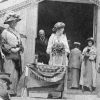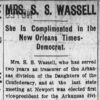calsfoundation@cals.org
Political Equality League
The Progressive Era (circa 1890–1920) in Arkansas included efforts by citizens to win voting rights for women in the state and nation. Women’s clubs that were interested in civil rights, temperance, and social change gradually formed suffrage groups to push the Arkansas General Assembly toward state suffrage for women and toward approval of the Nineteenth Amendment to the U.S. Constitution that enfranchised women nationally. Many women who led such groups were outsiders who also had legal training or were lawyers. The Political Equality League (PEL), formed in 1911 in Little Rock (Pulaski County), is considered by historians to be a culminating group that worked with similar organizations, both state and national, for the next eight years to win suffrage for women in Arkansas primaries in 1918 and to press for passage of the critical Nineteenth Amendment.
After the Civil War, the Arkansas constitutional convention convened in 1868 with suffrage for women and others as part of the agenda. However, there was inadequate support for the proposal by Arkadelphia (Clark County) convention representative Miles L. Langley, and it failed. Beginning about 1870, Arkansas hosted suffrage trailblazers such as Missouri’s Phoebe Wilson Couzins as speakers, winning praise from Little Rock newspapers. By 1881, the Arkansas Woman Suffrage Association (AWSA) formed in Eureka Springs (Carroll County), with attorney Lizzie Dorman Fyler of Massachusetts as president. The organization, however, was dissolved in October 1885.
In 1881, Mary W. Loughborough began what would eventually become the Southern Ladies’ Journal, which discussed suffrage issues, in Little Rock. In 1888, temperance activist Clara A. McDiarmid organized a suffrage association in Little Rock called the Arkansas Woman’s Suffrage Association or the Arkansas Equal Suffrage Association. When McDiarmid died in 1899, there was a temporary void in Arkansas suffrage leadership.
In the years leading up to the formation of the PEL, the “new women” who were coming to lead the suffrage movement typically were middle class and educated. Arkansas historian Frances Mitchell Ross found that while such a woman’s first responsibility was still to home and family, “she was to go beyond church work in the public arena in an effort to remake the world in the image of the one: to purify, uplift, control, and reform.”
In October 1911, the PEL is alternately reported to have formed either in a committee room at the Arkansas State Capitol building or at the home of Lulu Alice Markwell. Mary Fletcher (sister of Adolphine Fletcher Terry, an Arkansas activist and suffragist) became president of its seventy-five members. Mary Hutton (Mrs. W. P. Hutton) became vice president. The league formed in response to a pro-suffragist article written by Terry that was published on the front page of the influential Arkansas Gazette. The Terry family was socially prominent and had access to powerful people in the community and state. Mary Fletcher made a distinction between “suffragists” and “suffragettes,” distancing her group publicly in 1911 from the perceived militancy of suffragettes on the national stage. Fletcher emphasized that, “in the South, women do not find it necessary to fight for what we want.” The organization usually met twice a month for informational programs, and it initially included eight male members. Annual membership cost one dollar.
Some members of the league came from the ranks of the Woman’s Christian Temperance Union (WCTU). The most immediate task of the league was to support a proposed state constitutional amendment for suffrage proposed in 1911. The Arkansas Democrat newspaper took the position that most women were uninterested in suffrage and would not choose to vote. Despite hearings and passage of the amendment in the Arkansas Senate, the House defeated the measure partly because of the influence of the liquor lobby that disliked some suffragists’ anti-liquor stance.
By 1914, the league had expanded well beyond Little Rock to Hot Springs (Garland County), Pine Bluff (Jefferson County), Augusta (Woodruff County), Malvern (Hot Spring County), and Fayetteville (Washington County). The league acknowledged the need for a statewide suffrage group and supported the establishment of the Arkansas Woman Suffrage Association (AWSA) in late 1914. That same year, the PEL joined the AWSA and the National Women’s Suffrage Association (NAWSA) in providing “schools” to educate the public about suffrage as the movement gained momentum. The PEL also sponsored Arkansas’s first National Suffrage May Day at the historic Old State House on May 2, 1914, in Little Rock.
In 1915, the league joined the Arkansas Federation of Women’s Clubs (AFWC) and other groups to advocate for a state suffrage amendment. Suffrage leaders addressed the legislature, and the measure passed, but it was never put before Arkansas voters. The Jonesboro Daily Tribune, however, wrote in October, that “whether the conservative politician wills it or not, woman suffrage is coming in Arkansas.” The newspaper observed, “The signs of the times are too unmistakable to admit of argument.”
Visits to Arkansas by national suffragist leaders such as Carrie Chapman Catt of the National American Woman Suffrage Association and President Alice Paul of the National Woman’s Party (NWP), refocused Arkansas women’s attention on the national suffrage amendment even as their organizations sought rights to vote in primaries in their own state.
In October 1916, the league took part in a state convention of the Arkansas Suffrage Association in Pine Bluff. In 1917, an Arkansas woman suffrage bill passed that would allow women to vote in 1918 elections. More than 40,000 women did so. This made Arkansas the first non-suffrage state in America to allow women to vote in primary elections. It also enabled women to become delegates to the Democratic State Convention for the first time.
Pressure from the PEL and like-minded women’s groups led to ratification of the Nineteenth Amendment in a special session of the Arkansas General Assembly called by Governor Charles H. Brough on July 28, 1919. Arkansas was the twelfth state to ratify the amendment that became law on August 26, 1920. Information on the PEL after the passage of the Nineteenth Amendment is sparse, and the organization apparently ceased to exist, its main goal having been met.
For additional information:
Bayless, Stephanie. Obliged to Help: Adolphine Fletcher Terry and the Progressive South. Little Rock: Butler Center Books, 2011.
Cahill, Bernadette. Alice Paul, the National Woman’s Party and the Vote: The First Civil Rights Struggle of the 20th Century. Jefferson, NC: McFarland, 2015.
———. Arkansas Women and the Right to Vote: The Little Rock Campaigns, 1868–1920. Little Rock: Butler Center Books, 2015.
Ross, Frances Mitchell. “The New Woman as Club Woman and Social Activist in Turn of the Century Arkansas.” Arkansas Historical Quarterly 50 (Winter 1991): 317–351.
Taylor, A. Elizabeth. “The Woman Suffrage Movement in Arkansas.” Arkansas Historical Quarterly 15 (Spring 1956): 17–52.
Williams, C. Fred, S. Charles Bolton, Carl H. Moneyhon, and LeRoy T. Williams, eds. A Documentary History of Arkansas. 2nd ed. Fayetteville: University of Arkansas Press, 2013.
Jeanne Norton Rollberg
Little Rock, Arkansas
 Early Twentieth Century, 1901 through 1940
Early Twentieth Century, 1901 through 1940 Warner, Julia McAlmont
Warner, Julia McAlmont Wassell, Elizabeth McConaughey (Bettie)
Wassell, Elizabeth McConaughey (Bettie) Political Equality League Article
Political Equality League Article 




Comments
No comments on this entry yet.